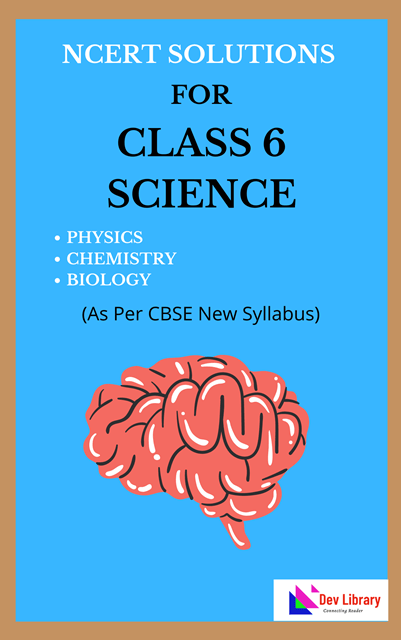NCERT Class 6 Science Chapter 13 Fun With Magnets Solutions to each chapter is provided in the list so that you can easily browse through different chapters NCERT Class 6 Science Chapter 13 Fun With Magnets and select need one. NCERT Class 6 Science Chapter 13 Fun With Magnets Question Answers Download PDF. NCERT Class 6 Science Solutions.
NCERT Class 6 Science Chapter 13 Fun With Magnets
Also, you can read the NCERT book online in these sections Solutions by Expert Teachers as per Central Board of Secondary Education (CBSE) Book guidelines. CBSE Class 6 Science Solutions are part of All Subject Solutions. Here we have given NCERT Class 6 Science Chapter 13 Fun With Magnets and Textbook for All Chapters, You can practice these here.
Fun With Magnets
Chapter: 13
NCERT TEXT BOOK EXERCISES
Q. 1. Fill in the blanks:
(i) Artificial magnets are made in different shapes such as __________ and __________.
Ans: (i) Bar magnet, horse shoe magnet and round shaped magnet.
(ii) The materials which are attracted towards magnet are called _____________.
Ans: Magnetic materials.
(iii) __________ is not a magnetic material.
Ans: Leather.
(iv) In olden days, sailors used to find direction by suspending a piece of _____________.
Ans: Suspended magnet.
(v) A magnet always has _____________ poles.
Ans: Two.
Q. 2. State whether the following statements are true or false:
(i) A cylindrical magnet has only one pole.
Ans: False.
(ii) Artificial magnets were discovered in Greece.
Ans: True.
(iii) Similar poles of a magnet repel each other.
Ans: True.
(iv) Maximum iron filings stick in the middle of a bar magnet when it is brought near them.
Ans: False.
(v) Bar magnets always point towards North-South direction.
Ans: True.
(vi) A compass can be used to find East-West directions at any place.
Ans: False.
(vii) Rubber is a magnetic material.
Ans: False.
Q. 3. It was observed that a pencil sharpener gets attracted by both the poles of a magnet, although its body is made of plastic.. Name the material that might have been used to make some part of it.
Ans: A pencil sharpener is made up of iron metals – which is attracted towards the magnet. To some parts of it are made of iron/ cobalt, which are magnetic materials.
Q. 4. Column I shows different positions in which one pole of a magnet is placed near that of the other. Column II indicates the resulting action between them for each situation. Fill in the blanks:
| Column I | Column II |
| N-N N-? S-N ?-S | ———— Attraction ———— Repulsion |
Ans:
| Column I | Column II |
| N-N N-S S-N S-S | Repulsion Attraction Attraction Repulsion |
Q. 5. Write any two properties of a magnet.
Ans: Properties of a magnet:
1. A magnet attracts magnetic material such as iron, cobalt and nickel towards it.
2. When a magnet is suspended freeh it stands always in North-South direction.
3. Magnetic influence can pass through a screen of cloth, plastic and papers.
Q.6. Where are poles of a bar magnet located?
Ans: A freely magnet always mes to rest in one direction, i.e., North- South direction.
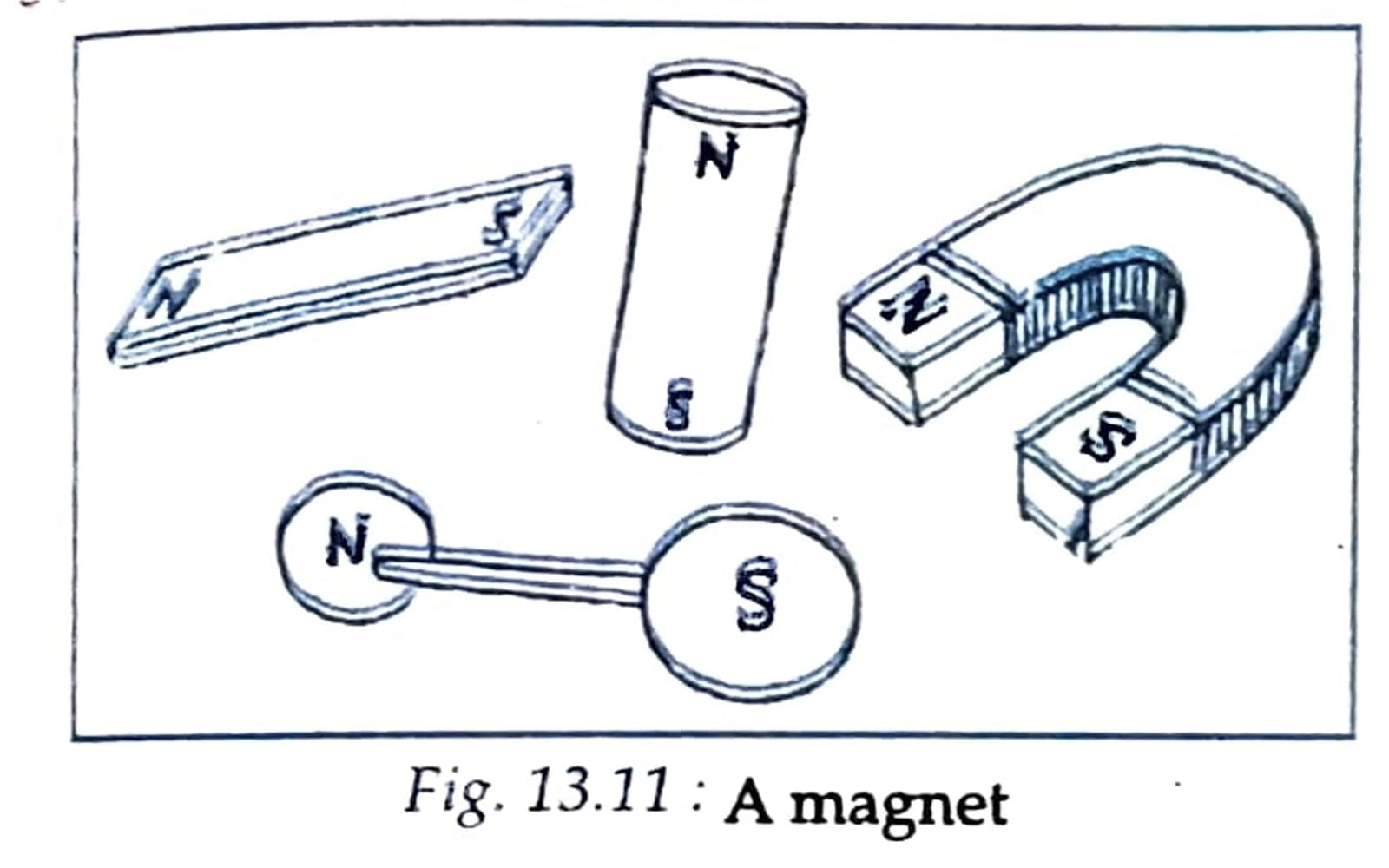
The end point of the magnet pointing towards north is called north pole and end pointing towards south is called south pole.
Thus we can see that a magnet has two poles:
(i) North pole.
(ii) South pole.
North and South poles are marked on the magnet.
Q. 7. A bar magnet has no markings to indicate its pole. How would you find out near which end is its north pole located?
Ans: We take a bar magnet and tied it with a thread in the middle. Now it is suspended freely tied the thread in a stand.
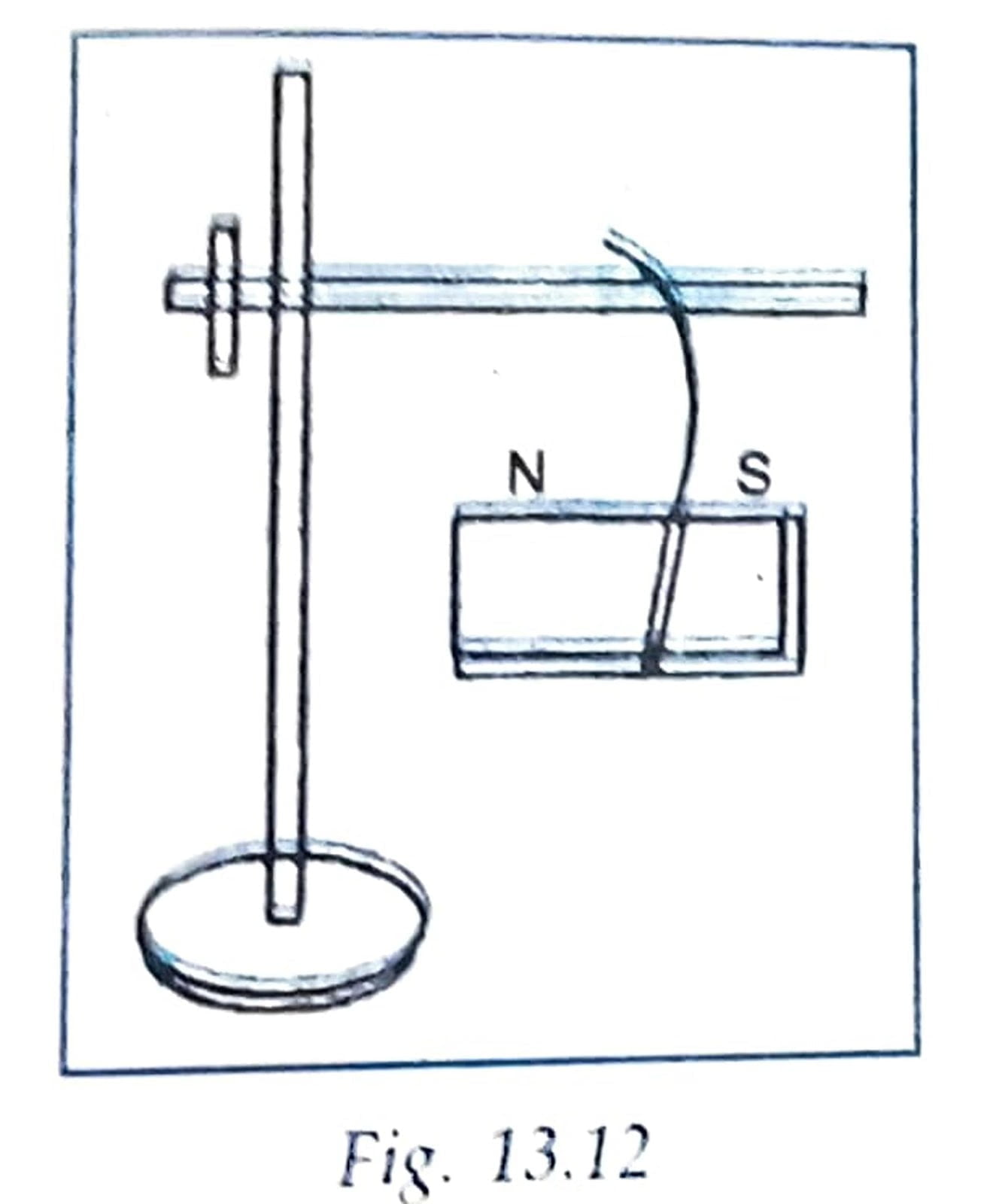
We find that bar magnets stay in North- South directions.
The pole which is towards north is called north pole of the bar magnet.
Thus we can find the poles of a magnet.
Q. 8. You are given an iron strip. How will you make it into a magnet?
Ans: Method of making an Iron strip a magnet: Take the iron strip and place it on the table. Strike it with one pole of a bar magnet in one direction. When you reach the other end of the iron stick, leave the magnet and bring the same pole back- to the starting end of the iron stick. Strike again in the same direction. Repeat this process about 30-40 times. Check whether the iron piece has now become a magnet. If not, continue the process for some more time. Remember that the pole and the direction of the magnet is not to be changed.
In this way, an iron stick can be converted into a magnet. (See Fig. 13.13)
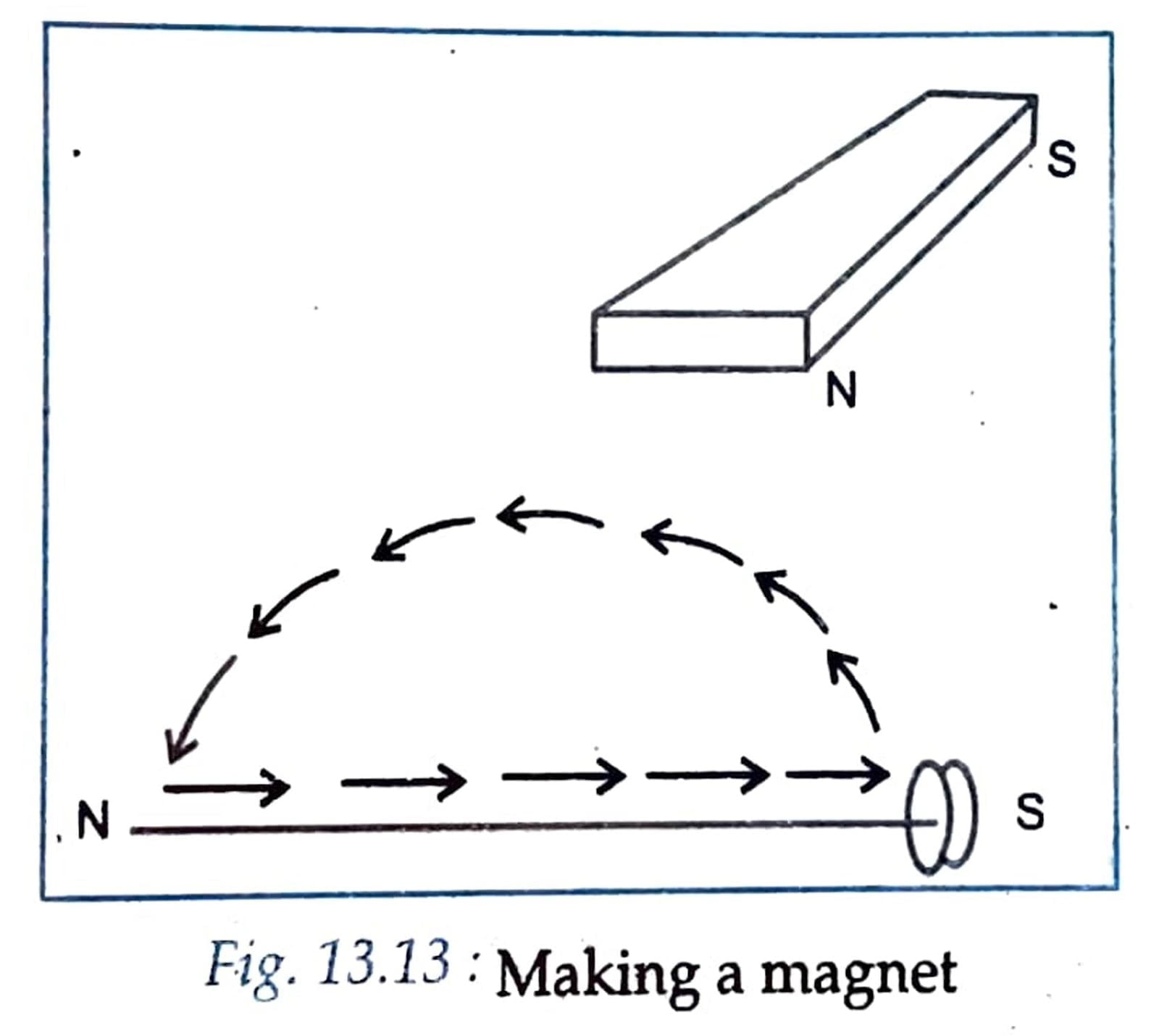
Q. 9. How is a compass used to find directions?
Ans: A compass is made on the property of a magnet, staying in north-south direction. This is a small glass case containing a magnetised needle pivoted on a nail. The needle can rotate freely. Whenever it is kept, its needle always rests in north-south direction (see Fig. 13.14)
Normally the north pole of the needle is painted red or some other indication is given t identify north and south poles. So using this needle, north and south can be identified.
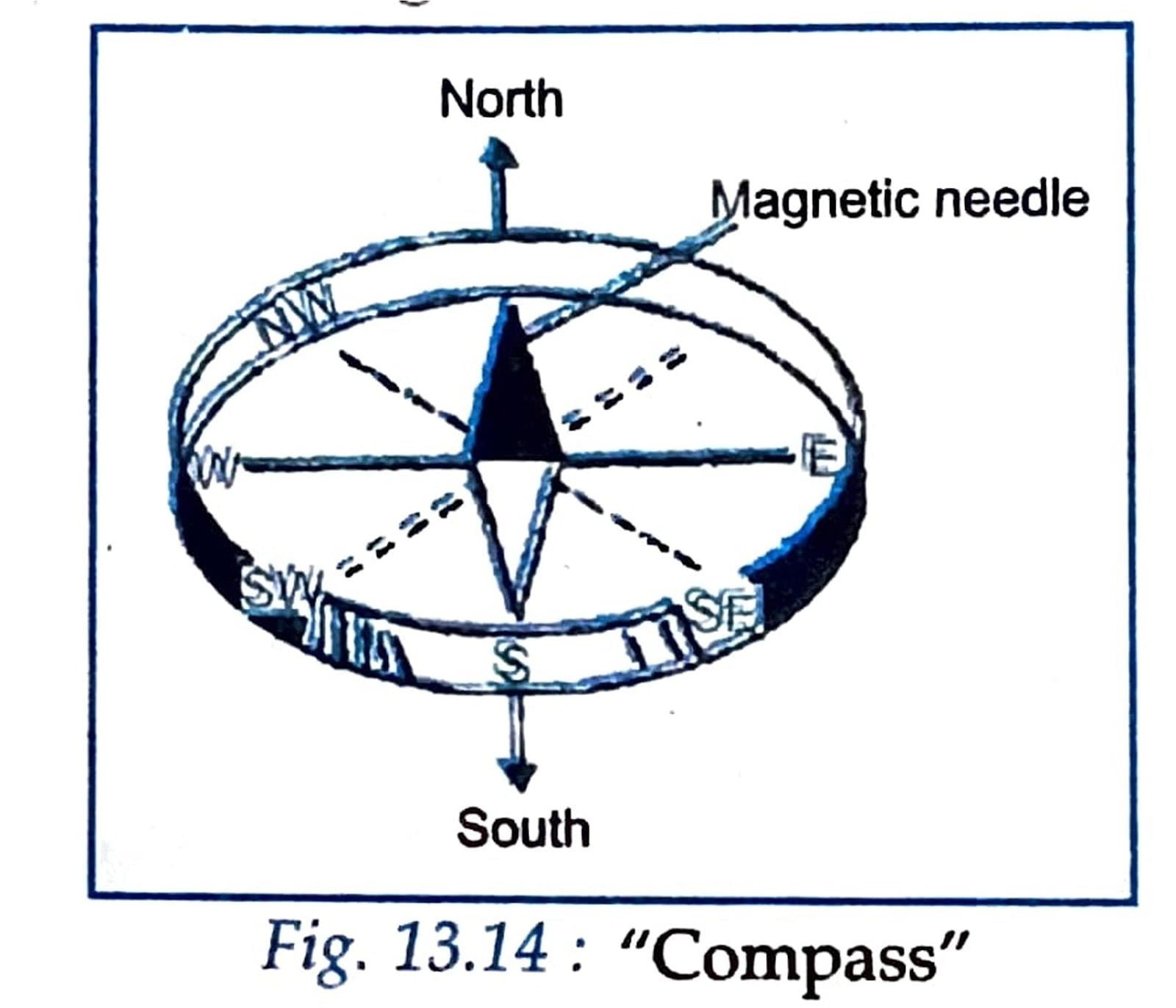
Q. 10. A magnet was brought from different directions towards a toy boat that ha been floating in water in a tub. Affect observed in each case is stated in column IT. Possible reasons for the observed affects are mentioned in column II. Match the statements gives in column I with those in column II.
| Column I | Column II |
| (A) Boat gets attracted towards magnet. | (a) Boat is fitted with a magnet with north pole towards its head. |
| (B) Boat is not affected by the magnet. | (b) Boat is fitted with a magnet with south pole towards its head. |
| (C) Boat moves towards the magnet if north pole of the magnet is brought near its head. | (c) Boat has a small magnet fixed along it’s length. |
| (D) Boat moves away from the magnet when the north pole is brought near its boat. | (d) Boat is made of magnetic material. |
| (E) Boat floats without changing its attraction. | (e) Boat is made up of non- magnetic material. |
Ans:
| Column I | Column II |
| (A) Boat gets attracted towards magnet. | (d) Boat is made of magnetic material. |
| (B) Boat is not affected by the magnet. | (c) Boat has a small magnet fixed along it’s length. |
| (C) Boat moves towards the magnet if north pole of the magnet is brought near its head. | (b) Boat is fitted with a magnet with south pole towards its head. |
| (D) Boat moves away from the magnet when the north pole is brought near its boat. | (a) Boat is fitted with a magnet with north pole towards its head. |
| (E) Boat floats without changing its attraction. | (e) Boat is made up of non- magnetic material. |
SOME OTHER IMPORTANT QUESTIONS FOR EXAMINATION
VERY SHORT ANSWER QUESTIONS
Q. 1. What is a magnet?
Ans: A Magnet is an object which attracts things made of iron, steel, nickel and cobalt.
Q. 2. Name an instrument which is used to find directions.
Ans: Compass.
Q. 3. Name a natural material which acts like a magnet.
Ans: Magnetite.
Q. 4. Name two magnetic materials.
Ans: (i) Iron.
(ii) Cobalt.
Q.5. It was observed that a pencil sharpener gets attracted by both the poles of magnet although its body is made of plastic. Name a magnetic material that might have been used to make some part of it.
Ans: Steel blade.
Q. 6. What name is given to the two ends of a magnet where the attraction is strongest?
Ans: Poles.
Q.7. A freely suspended bar magnet always aligns itself along a particular direction. Name this direction.
Ans: North-South direction.
Q.8. In which direction the pointed end of the needle of a compass always points?
Ans: North.
Q. 9. State whether attraction or repulsion will be produced when:
(a) N-pole is brought near to another N-pole.
Ans: Repulsion.
(b) N-pole is brought near to S-pole.
Ans: Attraction.
Q. 10. (a) Name two magnetic poles which attract each other.
(b) Name two magnetic poles which repel each other.
Ans: (a) North pole and South pole.
(b) North pole and North pole.
Q. 11. You are given two similar steel bars one of which is a magnet. What else would you require to test which of the given steel bars is a magnet?
Ans: Any object made of iron or steel(such as paper clip).
Q. 12. An iron bar A is attracted by a magnet at one end but repelled at the other end. Another iron bar B is attracted by the magnet at both the ends. Which of the two iron bars, A or B could be a magnet?
Ans: Iron bar A.
Q. 13. At which place on a magnet, its magnetic force is maximum?
Ans: At poles.
Q. 14. What happens when N-pole of a magnet is brought near the N-pole of a suspended magnet?
Ans: There is repulsion between these two magnets as there is repulsion between like poles.
Q. 15. Name the compound of iron contained in lodestone.
Ans: Magnetite.
Q. 16. What is a compass needle?
Ans: A compass needle is a small bar magnet.
Q. 17. What type of magnetic pole is (a) X and (b) Y?
Ans: (a) North (N) pole.
(b) South (S) pole.
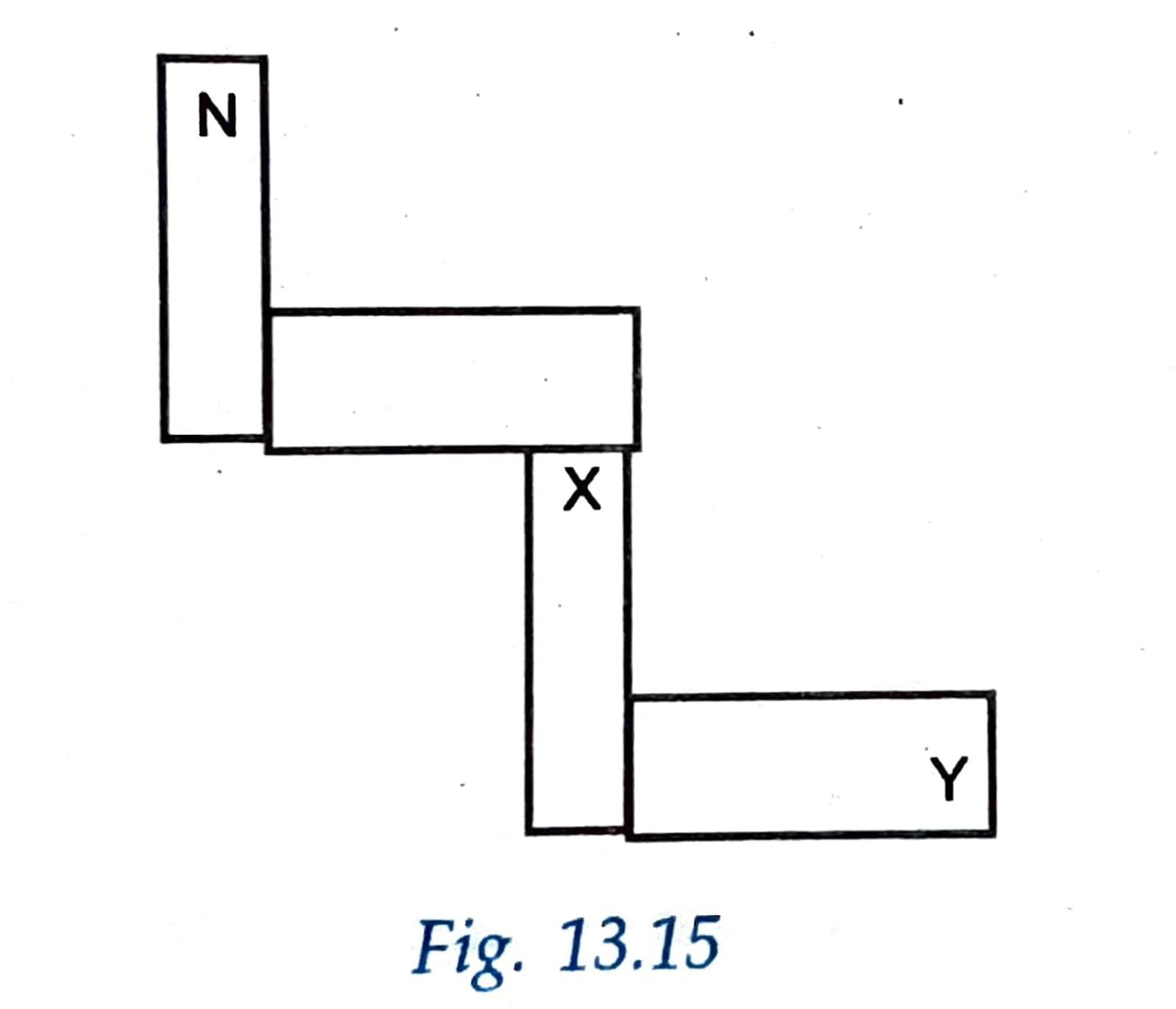
Q. 18. State one way in which magnetisation can be lost.
Ans: Magnetisation can be lost by heating.
Q.19. What is magnetic keeper?
Ans: Magnetic keepers are the pieces of soft iron used to reduce the self- demagnetisation when not in use.
Q. 20. What is a natural magnet?
Ans: The magnets or lodestones found in nature are called natural magnets.
Q. 21. How will you test whether a given rod is made of iron or not?
Ans: If this rod is attracted by a magnet, it is made of iron and if not then it is not made of iron.
Q. 22. Can we have an isolated north pole or south pole?
Ans: We cannot have an isolated north pole or south pole. They always exist in opposite direction.
Q. 23. A bar magnet attracts iron filings more strongly at two ends. What are these end points called?
Ans: These end points of the bar magnet are called its poles.
Q. 24. What is a sure test of magnetism?
Ans: Repulsion is a sure test of magnetism.
Q. 25. Which material do you think is common in all the ordinary objects which are attracted by a magnet?
Ans: Iron (or steel)..
SHORT ANSWER QUESTIONS
Q. 1. Study the magnets X and Y given below:

(a) If B is the north pole of the magnet X, which is the north pole of magnet Y?
Ans: D
(b) What will happen when A is brought close to C?
Ans: Magnets will repel each other.
Q. 2. Name two methods by which a magnet can be demagnetised.
Ans: (i) By hammering the magnet strongly.
(ii) By heating a magnet strongly and keeping it in the east-west direction.
Q. 3. It is advised to keep the magnets away from television, mobiles, CD and computers. Explain why?
Ans: Television, mobiles, CD, computers and many more devices are made up of magnetic materials and magnets in it. If you bring a magnet closer to it then it will spoil these devices.
Q. 4. A given bar magnet was broken into pieces. Where will be its North and South pole?
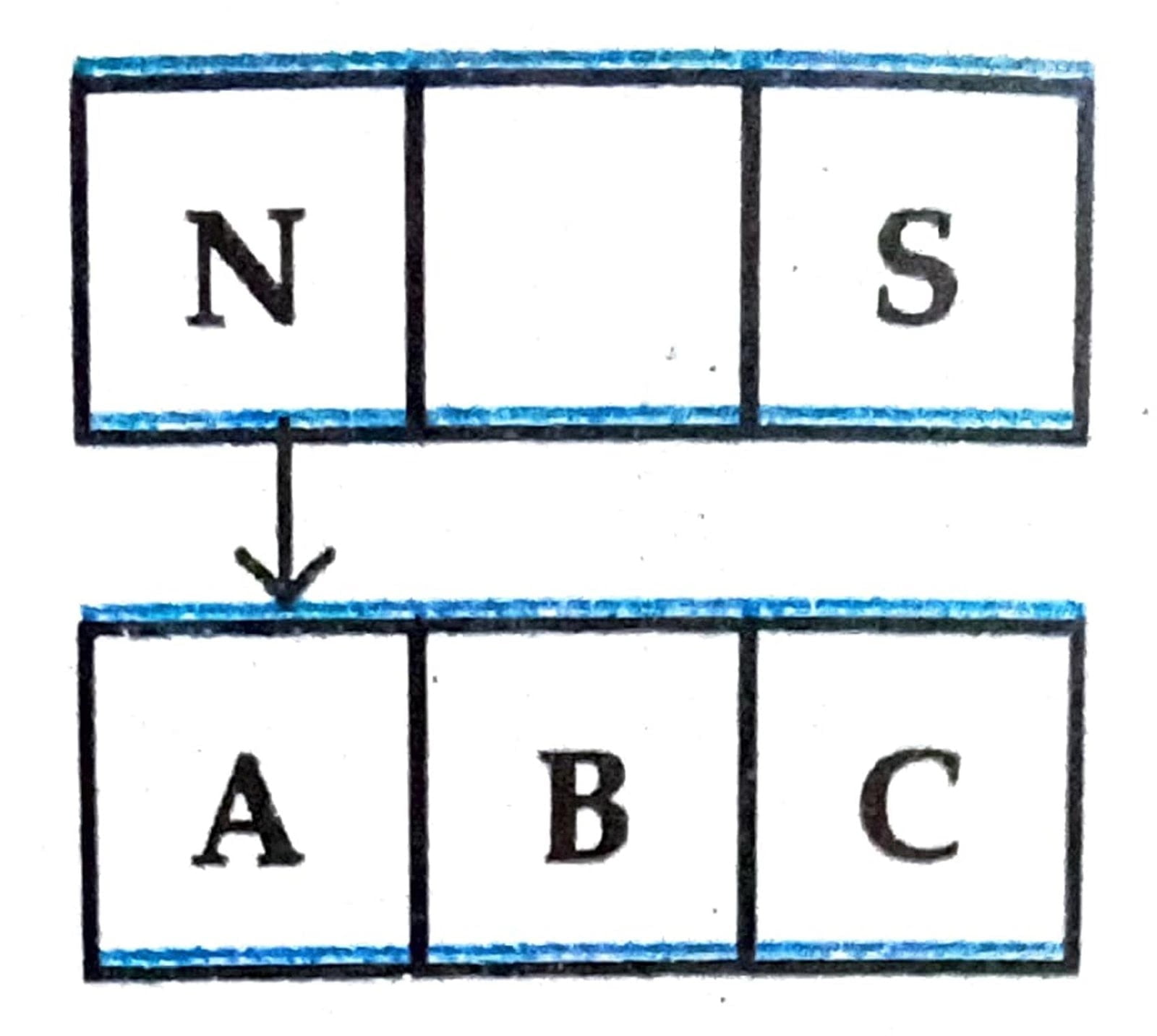
Ans: If you cut a bar magnet into pieces, then the end labelled as north remains north and the other end formed will be south. Similarly the end that was pointing south will be south pole and its opposite end will be the new north pole.
Q. 5. Why are the artificial magnets required?
Ans: The natural magnets are found in a quite irregular and odd shapes. They are not magnetically strong enough for use, therefore artificial magnets are required.
Q. 6. What are attractive and directive properties of a magnet?
Ans: (i) Attractive property: It attracts small pieces of iron towards itself. This is called attractive property.
(ii) It shaped in the form of a needle and suspended freely, it always points in the North-South direction. This is called directive property.
Q.7. Anand puts a car on an aluminium sheet. He then placed a magnet under the aluminium sheet shown in the diagram below. When he moved the magnet, the car also moved.
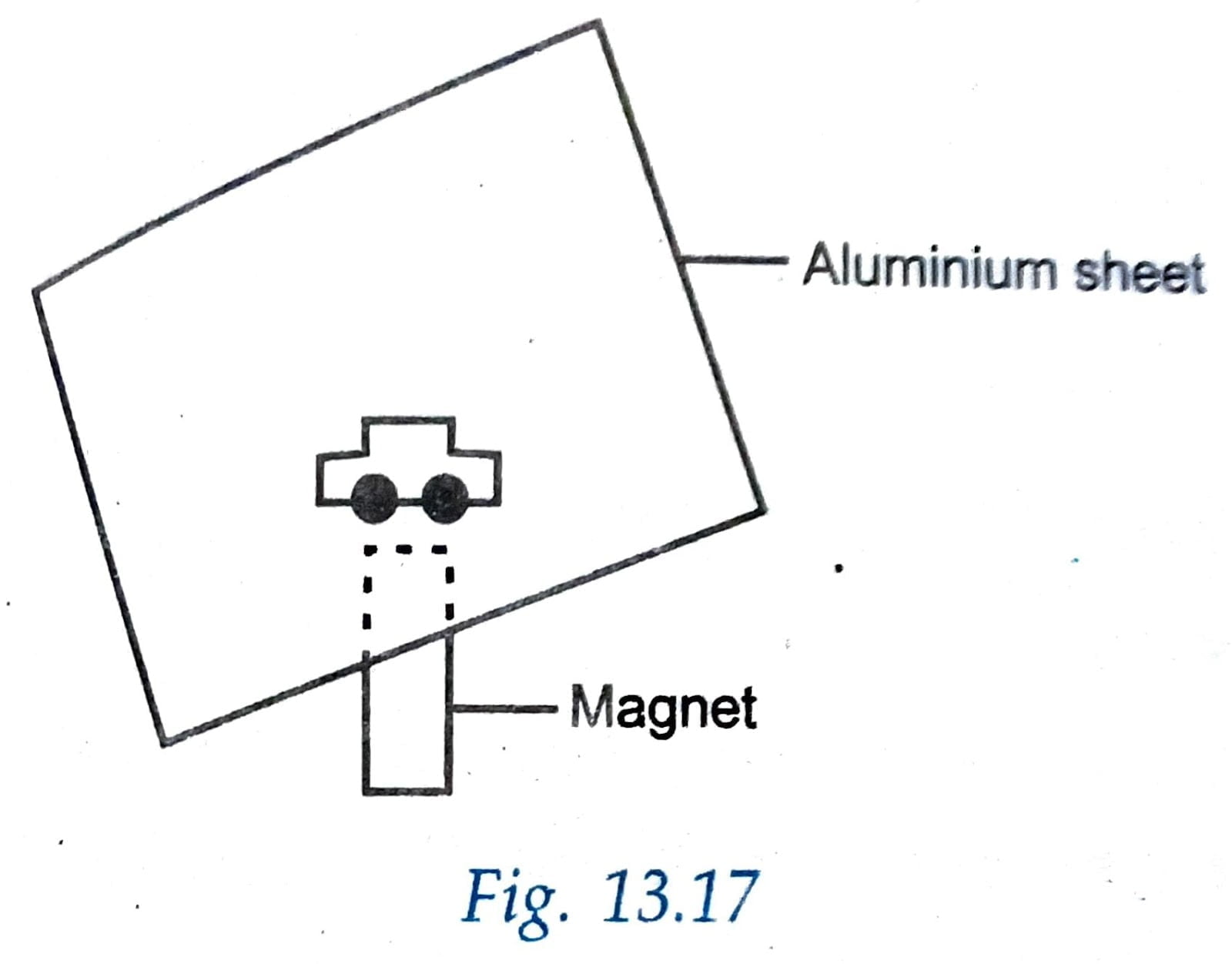
(a) What material is the car made of?
Ans: (a) Iron or steel.
(b) What does this activity tell us about aluminium?
Ans: Aluminium is not attracted by a magnet.
Q. 8. How will you distinguish two identical bars of iron as a permanent magnet and an ordinary piece of iron?
Ans: To identify the real magnet bring a third magnet near each end of the identical bars. In case of ordinary bar, both its end should be attracted towards magnet. But in case of a permanent magnet, one of its ends would be repelled.
Q. 9. What are called magnetic materials and non-magnetic materials? Give examples.
Ans: The materials, which get attracted towards magnet, are called magnetic materials. The materials, which are not attracted towards magnet, are known as non-magnetic materials.
Examples: Iron, nickel and cobalt are magnetic materials. Leather, plastic, cloth and paper are non-magnetic materials.
Q. 10. Draw a diagram of magnetic compass.
Ans:
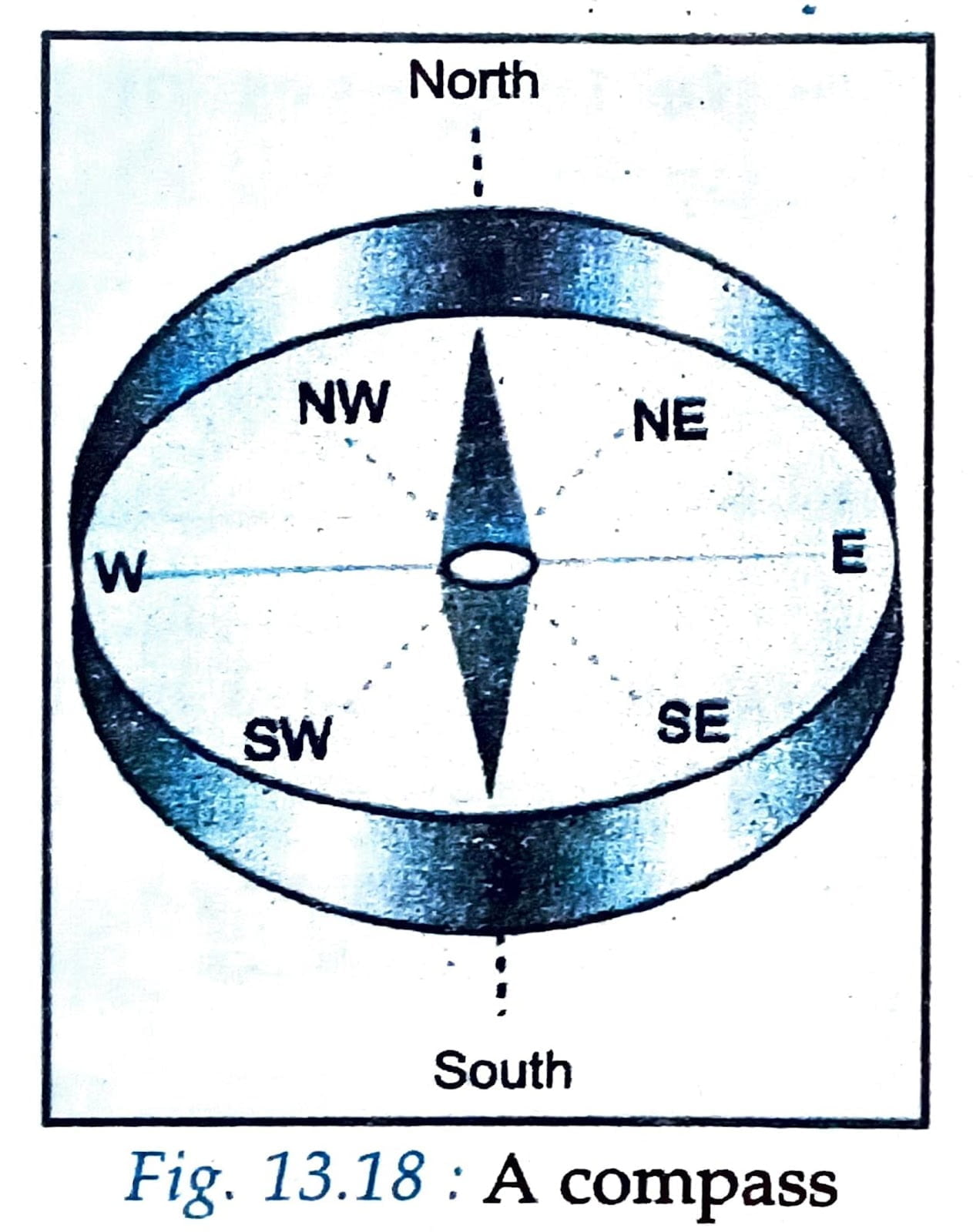
Q. 11. Magnet A is floating above magnet B as shown in the following diagram. What is the reason for this?
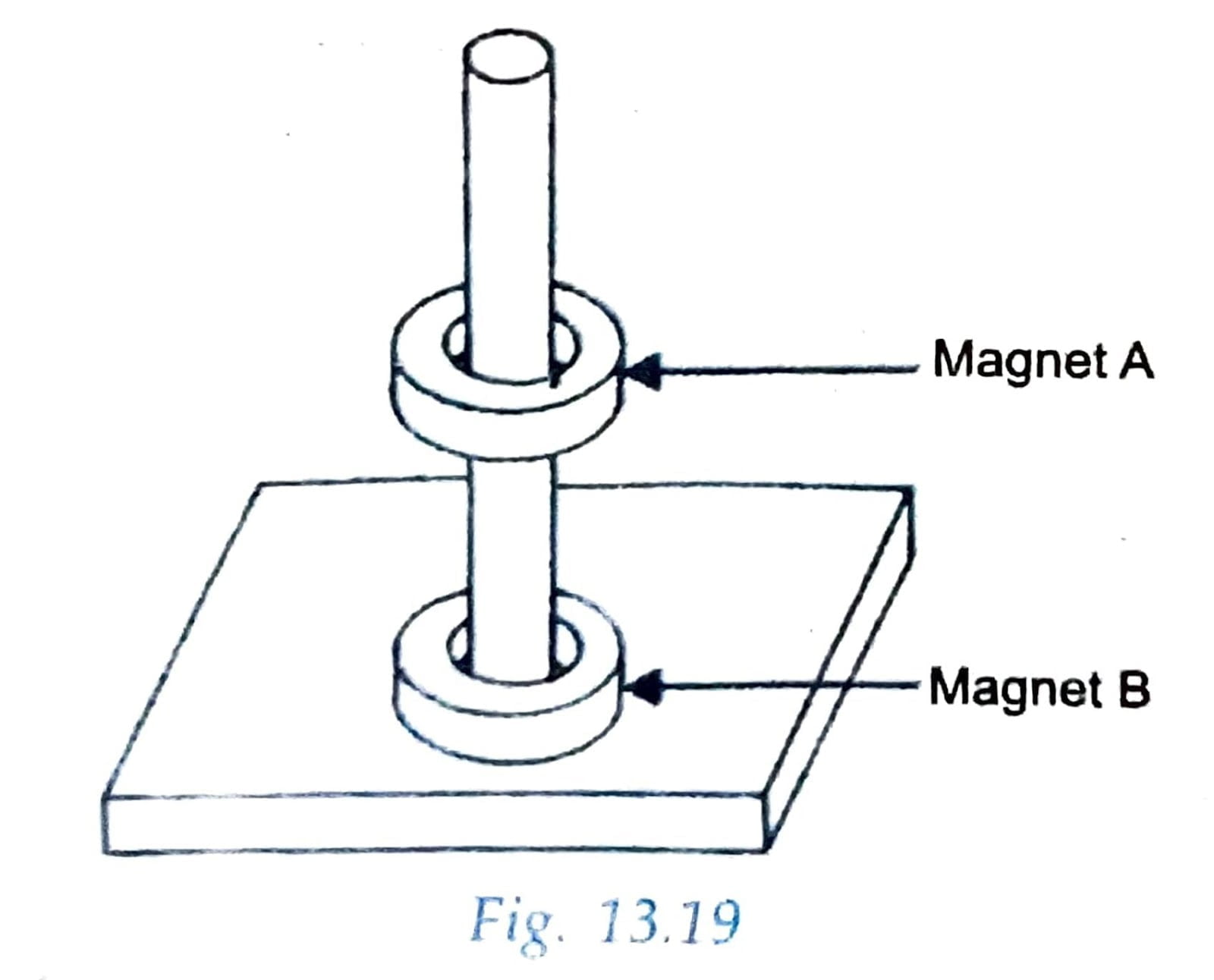
Ans: Like poles (or similar poles) of magnet A and magnet B are facing each other causing repulsion between the two magnets. This force of repulsion makes the magnet A float above magnet B.
Q. 12. Write four main properties of a magnet.
Ans: Properties of a magnet:
(i) Magnet has two poles – south pole and north pole.
(ii) Poles of magnet cannot be isolated.
(iii) Like poles repel each other and unlike poles attract each other.
(iv) Freely suspended magnet aligns in N-S direction.
Q. 13. State two uses of magnetic compass.
Ans: (i) To find magnetic north-south direction.
(ii) To find the direction of magnetic field at a point.
Q. 14. Give the common and chemical name of natural magnet.
Ans: Common name: Magnesia.
Chemical name: Magnetite.
Q. 15. How is self-demagnetisation of a magnet minimized by the use of magnetic keepers?
Ans: When a magnetic keeper is placed in contact with the opposite poles of the magnet, it acquires opposite polarity at its ends which attract the molecular magnets within the magnet and preserves the alignment of the molecular magnets. Hence, self-demagnetisation of a magnet is minimized.
SHORT ANSWER QUESTIONS
Q. 1. How will you test the polarity of a magnet?
Ans: The points on a magnet where the attraction appears to be maximum, are known as poles of the magnet. To locate the position of poles of a magnet, brought the magnet near the layer of iron filing, which sticks on the magnet. The place on the magnet where the sticking of iron filing is maximum is known as the poles of the magnet.
Q. 2. If a large number of pins from a pin box fall on the floor and get scattered, describe a method to collect all the pins quickly.
Ans: If a large number of pins from a pin box fall on the floor and get scattered, we can collect all the pins quickly by using a magnet. If we move a magnet over the pins scattered on the floor, all the pins (being magnetic) will get attracted to the magnet and stick to it. We can then remove those pins from the magnet and put them back in the box.
Q. 3. Few iron nails and screws get mixed with the wooden shavings while a carpenter was working with them. How can you help him in getting the nails and screws back from the scrap without wasting his time in searching with hands?
Ans: We can get back the nails and screws from the wooden shavings by using a magnet. If we move the magnet through the wooden shavings containing nails and screws, then the nails and screws (being magnetic) will get attracted to the magnet and stick to it. Wooden shavings are non- magnetic and hence they do not stick to the magnet.
Q. 4. Which observation led to the conclusion that magnetic poles occur in pairs and it is not possible to obtain an isolated magnetic pole?
Ans: Take a thin bar magnet. Check its two poles with the help of iron filings. Break this bar magnet into two pieces and check the broken pieces with the iron filings. Each broken piece acts as a magnet with its own two poles.
If we break each piece again and again,we will find that each smaller piece is a magnet with its own two poles.
This observation lead to the conclusion that magnetic poles occur in pairs and it is not possible to obtain an isolated magnetic needle
Q.5. Write three uses of a magnet.
Ans: Uses of a magnet:
(i) Magnets are used to hold objects (like stickers, refrigerator doors, pencil box lids, pins, etc.)
(ii) Magnets are used to separate discarded iron and steel objects from other waste (non-magnetic) materials.
(iii) Magnets are used for making compasses.
Q. 6. Describe carefully with the help of figure, how you could magnetize the blade of a knife so that the pointed end becomes north pole.
Ans: To magnetise knife such that its pointed end becomes north pole, we bring a bar magnet and touch its south pole to the pointed end of blade of knife as shown in figure. Due to induction, the pointed end of blade of knife acquires north polarity while the farther end acquires south polarity.

Q.7. Explain the statement that repulsion is a sure test of a permanent magnet.
Ans: Suspend a bar magnet with a silk thread and bring a iron rod near it. The rod will get attracted towards the magnet. When we bring the magnet near the suspended magnet, it will attract one and repel other ends. Thus repulsion is a sure test for a magnet.
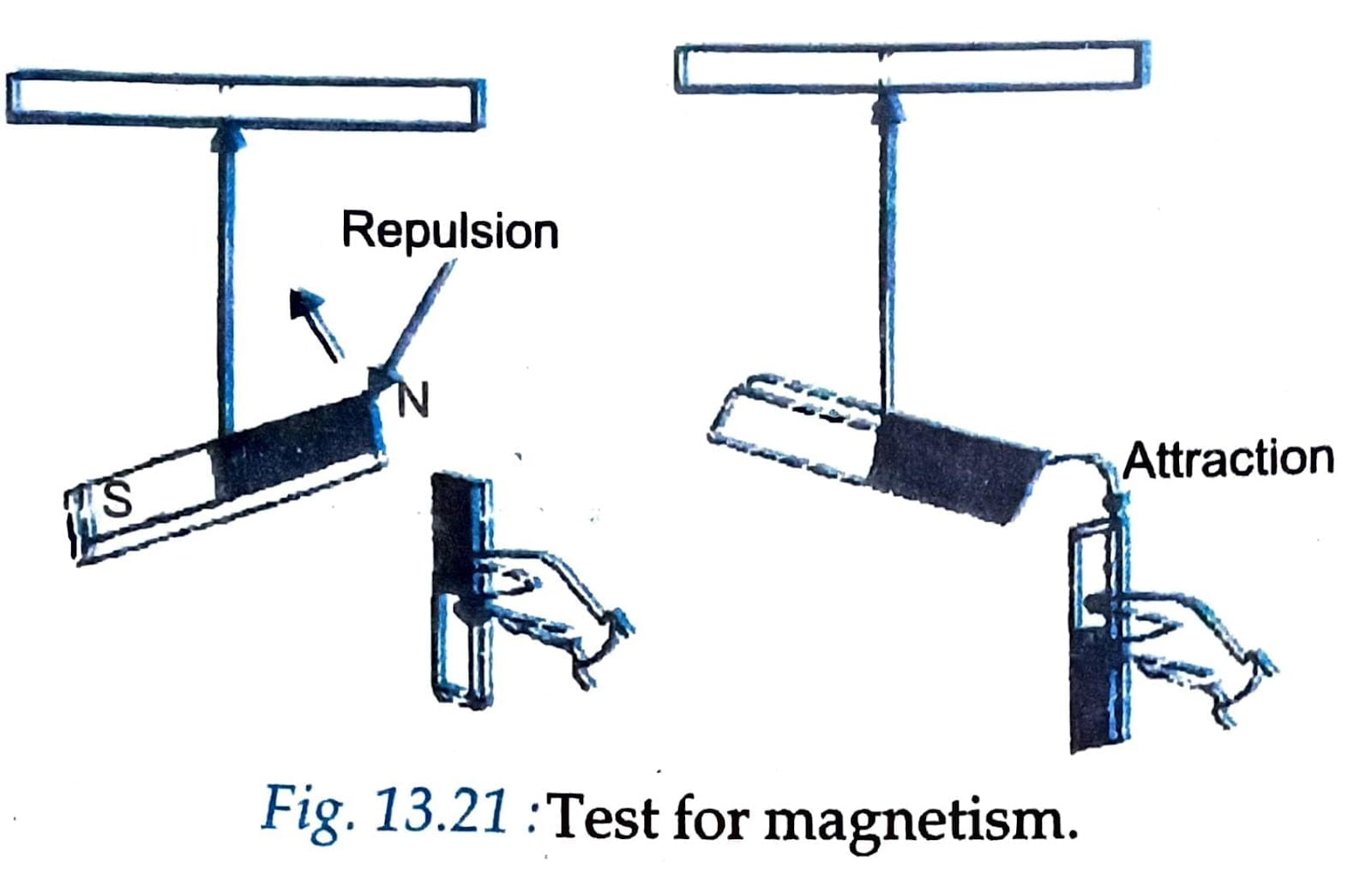
Q. 8. Every iron atom is a tiny magnet. Why all iron bars are not magnets?
Ans: Although every iron atom is a tiny magnet yet all iron bars are not magnets because in iron bar, all atoms are randomly arranged so the magnetic effect of each atom is canceled by the other, thus it is unmagnetised. But in the presence of any external magnetic field, tiny atomic magnets are oriented in similar direction so the bar becomes magnetized.
Q. 9. A horse-shoe magnet, when not in use, is kept with a metal piece M, that is held to the north and south poles as shown in the figure.
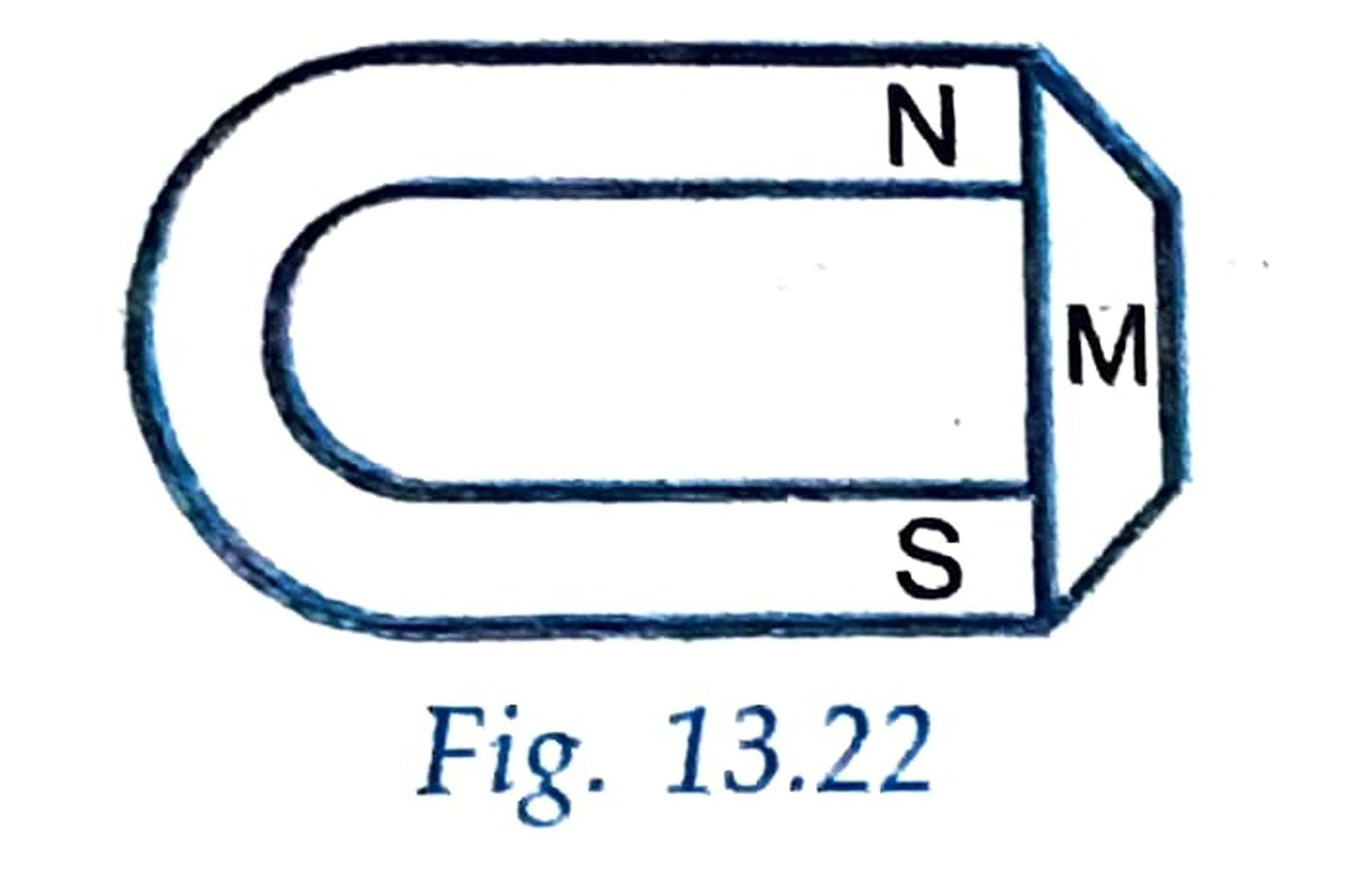
(a) What is the metal piece M called?
Ans: Metal piece M is called magnetic keeper.
(b) What is M made up of?
Ans: M is made up of soft iron.
(c) What is the function of piece M?
Ans: M reduces the self-demagnetisation of horse-shoe magnet during storing
Q. 10. Explain why iron filing sprinkled on a sheet of cardboard over a bar magnet take up definite position when the card board is slightly taped?
Ans: If a bar magnet is kept under a cardboard and the iron filing is sprinkled over it and the cardboard is taped gently then the iron filings arrange themselves in continuous closed curves due to the magnetic field of bar magnet. The iron filings are arranged in the form of magnetic lines of force. The position of iron filings is changed if the position of magnet is altered.
LONG ANSWER QUESTIONS
Q. 1. What are magnetic materials? Name two magnetic materials and two non- magnetic materials. Classify the following materials/objects into magnetic and non- magnetic materials:
Plastic button, aluminium spoon, knife blade, copper wire, iron nail, brass utensil pencil, rubber eraser, safety pin, paper clip.
Ans: Magnetic materials: Materials that get attracted to a magnet are called magnetic materials.
Examples: Metals such as iron, cobalt and nickel.
Non-magnetic materials: Materials that do not get attracted to a magnet are called non-magnetic materials.
Examples: Wood, paper and plastic.
Magnetic materials/objects: Knife blade, iron nail, safety pin.
Non-magnetic materials/objects: Plastic button, aluminium spoon, copper wire, brass utensil, pencil, rubber eraser, paper clip.
Q. 2. What is meant by the poles of a magnet? Where are the poles of a bar magnet located ? Draw a sketch to show the poles of a bar magnet.
Ans: The regions of a magnet where the attraction of magnet is the strongest are called poles of the magnet
The two poles of a magnet are near its free ends. One pole of the magnet is called north pole and the other pole of the magnet is called south pole.
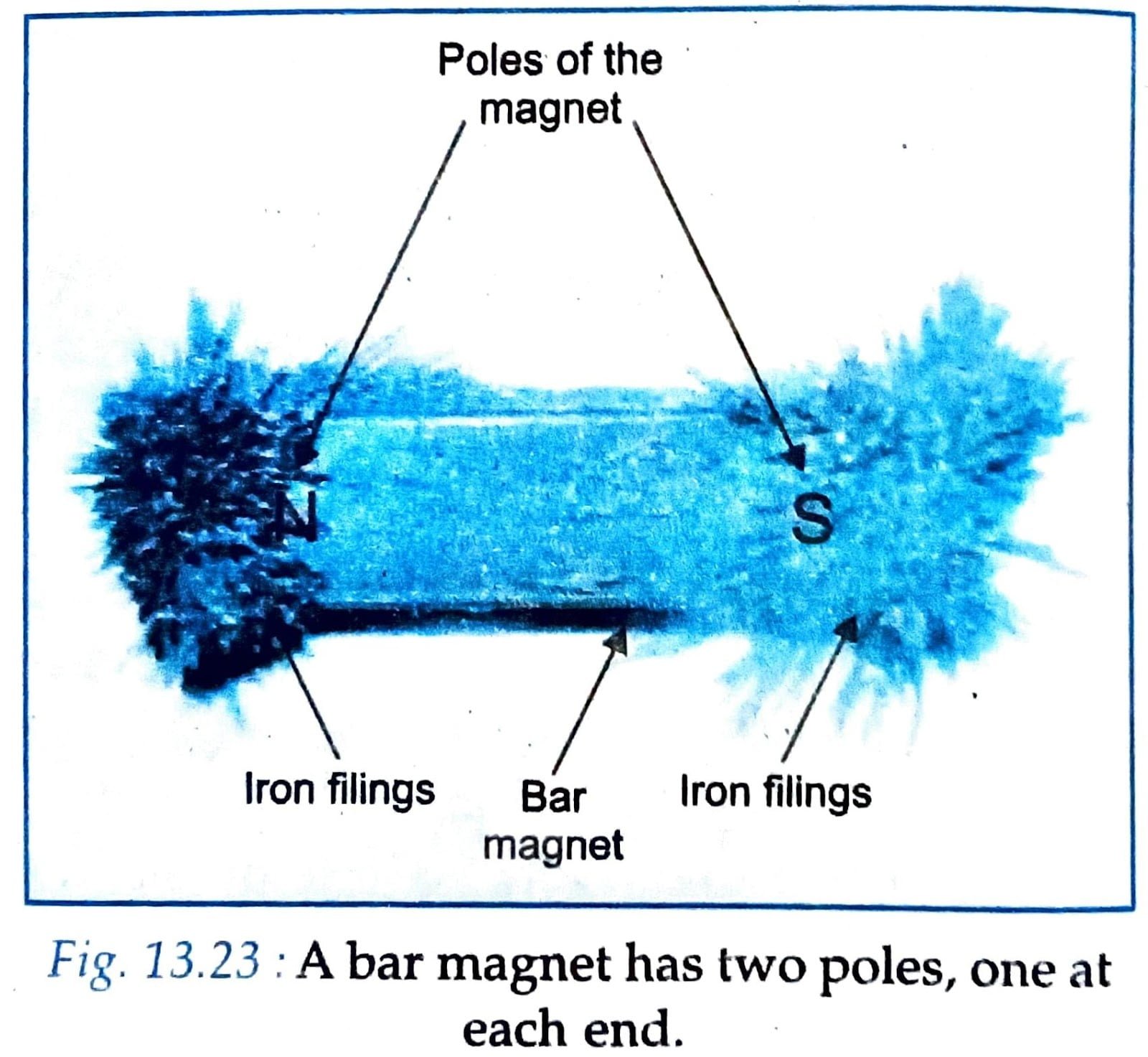
Q. 3. What is a compass? Describe the construction of a compass with the help of a labelled sketch. How is a compass used to find directions?
Ans: The compass is an instrument to find the directions of a place. The compass has a tiny magnet in the form of a needle which can rotate freely on a pivot (or pin). The pivoted magnetic needle of the compass is enclosed in a small brass box having a glass top. The compass has a circular dial with various directions marked on it. The needle of compass always comes to rest along the north-south directions. The north pole of compass needle is painted with different colour to distinguish it from the south pole.
In order to find the directions of a place, the compass is kept on a flat surface of that place. The needle of compass will soon come to rest along the north-south direction. The compass is then rotated until the pointed end of needle is towards N (North) mark on the dial and the other end of needle is towards S (South) mark on the dial. We can now find any direction by looking at the dial of the compass.
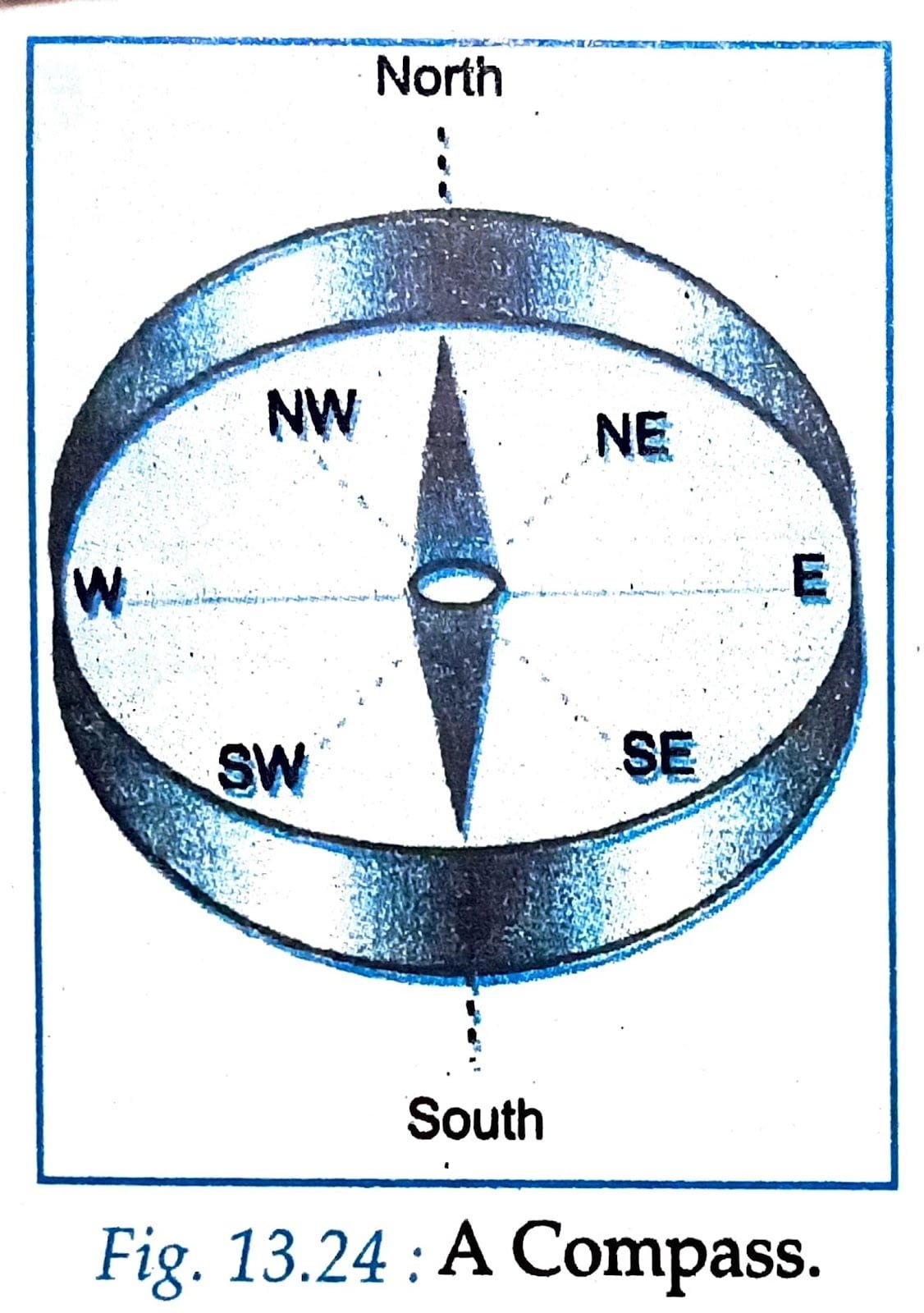
Q.4. Show that a magnet has two poles. What are the properties of the poles of a magnet?
Ans: We know that pole is the point where the strength of the magnet is maximum. So more and more iron filings will be attracted at poles of a magnet when we bring a magnet near the iron filings. We will observe the crowdedness of iron filings at the ends of magnet, this indicates the presence of two poles in a magnet. Hence poles are present in a magnet in pair. If a magnet is divided into two parts, each part also possesses a pair of poles.
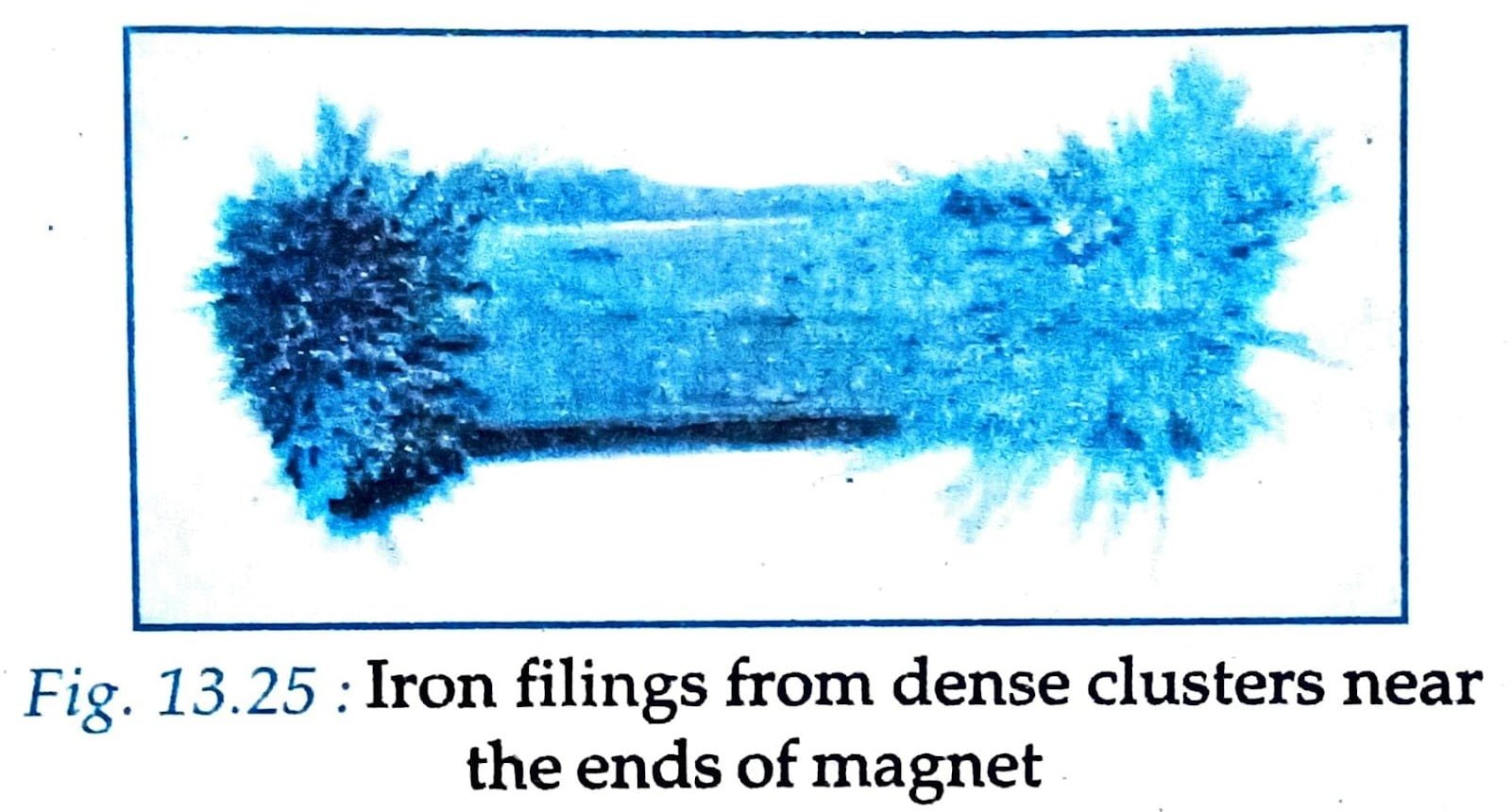
Q. 5. Describe an experiment to show the difference in magnetic property of soft iron and steel.
Ans: To show the difference in magnetic property of soft iron and steel, take an iron bar and a steel bar. Touch both of these to a strong bar magnet so both become magnetized by induction. Now, bring some iron filings near these bars. We will observe that soft iron bar attracts more filings than steel. Now, remove the bar magnet which was used for magnetization of bars, the iron bar and steel bar becomes demagnetise so all the filings fell down from soft iron bar but keep some filing remains clung from steel bar.
Higher Order Thinking Skill Questions
Q. 1. What do you mean by magnetic equator?
Ans: The line that joins the places the needle of a magnetic compass becomes horizontal, is called the magnetic equator.
Q. 2. State four properties of magnets.
Ans: (i) A freely suspended magnet always rests in north-south direction.
(ii) A magnet attracts small pieces of iron towards it.
(iii) Like poles repel while unlike poles attract each other.
(iv) Mono poles do not exist.
Q. 3. You are provided with two similar bars, one is a magnet and the other is soft iron. How will you distinguish between them without the use of any other magnet or bar?
Ans: Suspend both the bars freely and separately. The bar, which always sets in a definite direction is the magnet while the bar which does not set in a definite direction is iron bar.
Q. 4. A pair of bar magnet is to be stored. Draw a diagram showing the arrangement of the magnets and the keepers. Show clearly the polarity of magnets and keepers.
Ans: The following figure (13.27) shows the arrangement of magnets and the keepers to store the bar magnets.
Q.5. Draw the diagram of (a) Bar magnet, (b) Horse-shoe magnet.
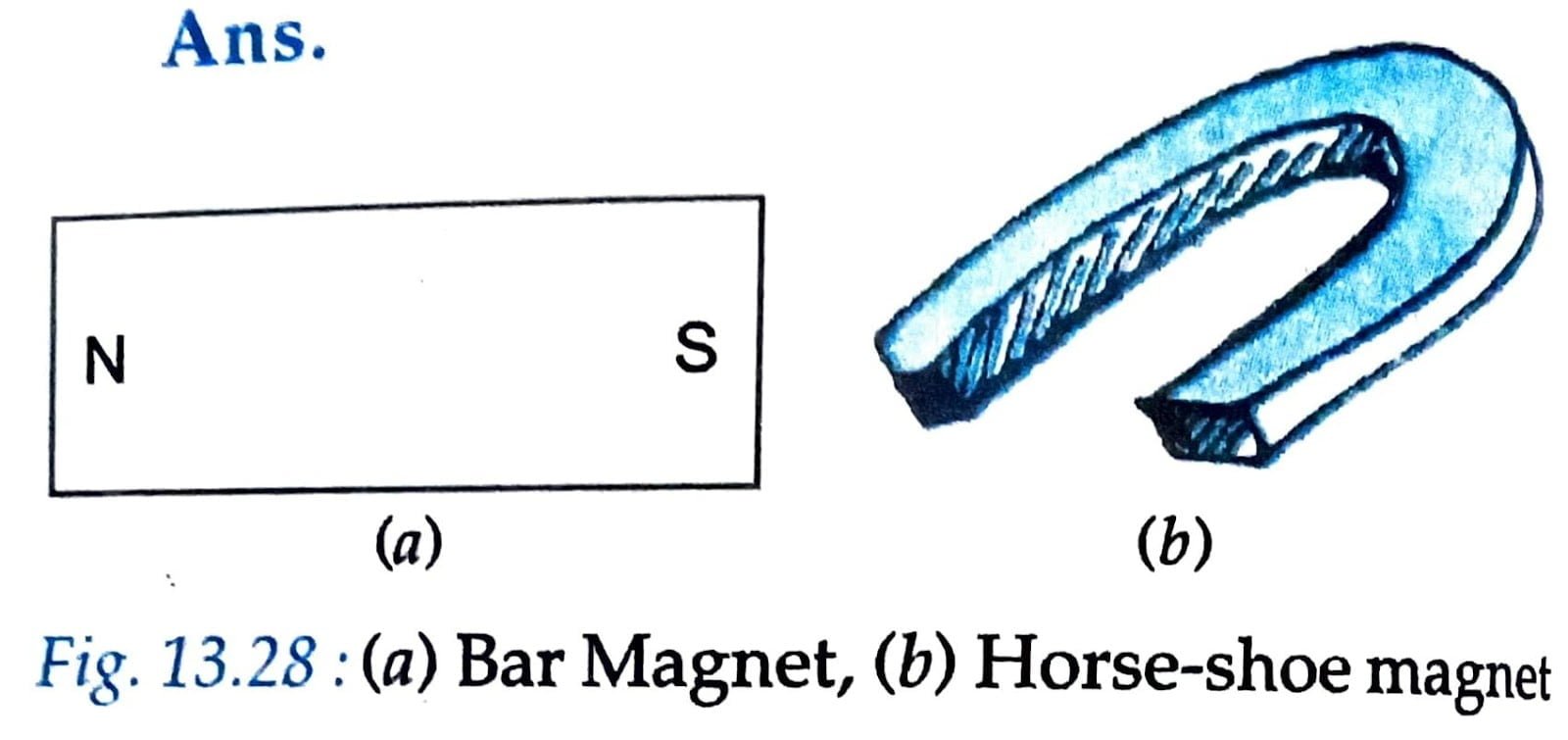
(SBQ) Skill Based Questions
Q. 1. Observe the following diagram which shows a paper clip hanging in air below a paper clip fixed with the help of a clamp.
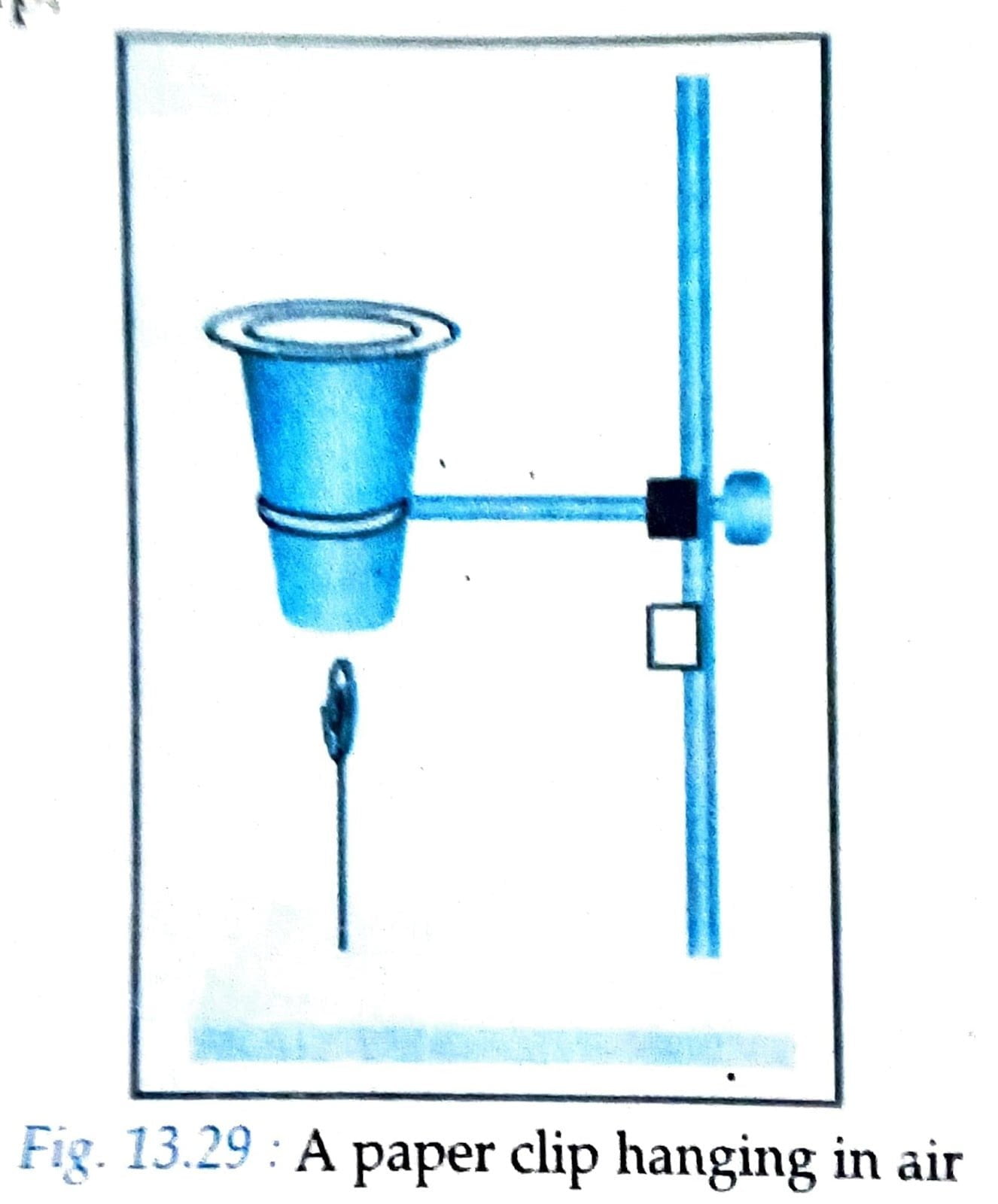
Ans: A magnet is placed inside the cup. The mouth of the cup is covered with a paper. So, that the magnet is not visible.
One end of a short thread made of iron is attached with the paper clip. The other end of the thread (thin iron wire) is fixed at the base of the stand.
When the clip will be brought near the base of the cup, the clip will hang in air without support because of magnetic effect.
Q. 2. Observe the diagram below in which heating and hammering of a bar magnet shown.

Answer the following question
What would be the of these activities?
Ans: The bar magnet will loose its magnetic properties.
FORMATIVE ASSESSMENT
Q.1. Fill in the following blanks with suitable words:
(i) The attraction of a magnet is strongest at its _____________.
Ans: Poles.
(i) The same type of magnetic poles are called ____________ poles whereas different types of magnetic are called ___________ poles.
Ans: Like, Unlike.
(iii) In order to convert an iron piece into a magnet, we should strike it with the same ____________ of a bar magnet in the ______________ direction repeatedly.
Ans: Pole, Same.
(vi) Like poles____________and unlike poles__________each other.
Ans: Repel, Attract.
(v) Strong magnet can be demagnetised by ____________.
Ans: Hammering strongly.
(vi) A compass shows the ____________.
Ans: Directions.
(vii) Magnetite is a ____________ magnet.
Ans: Natural.
(viii) The strength of a magnet is negligible at its _____________.
Ans: Centre.
(ix) The end of the magnet that points towards the north is called the ______________ pole.
Ans: North.
(x) In two ends of a magnet where the magnetic force is maximum are called the ___________ of the magnet.
Ans: Poles.
Q. 2. State whether the following statements are true or false:
(i) A compass needle is a magnet.
Ans: True.
(ii) A nickel wire is attracted by a magnet.
Ans: True.
(iii) A freely suspended bar magnet always points along East-West direction.
Ans: False.
(iv) Repulsion is a sure test of magnetization.
Ans: True.
(v) It is possible to obtain an isolated north pole of a magnet.
Ans: False.
(vi) The ends of a magnet has very weak magnetic field.
Ans: False.
(vii) A bar magnet has three poles.
Ans: False.
(viii) A wooden material can be magnetized.
Ans: False.
(ix) Compass is used to find direction.
Ans: True.
(x) Magnetite is a natural magnet.
Ans: True.
Q. 3. Match the items in Column A with those in Column B:
| Column A | Column B |
| 1. Poles of a bar magnet are present. | (a) Magnetic |
| 2. The rock that attracts iron pieces. | (b) Nickel and Cobalt |
| 3. The materials that get attracted towards a magnet. | (c) At the ends |
| 4. Except iron, these materials are also magnetic. | (d) North-South |
| 5. A freely suspended bar magnet always comes to rest in the direction | (e) Repel each other |
| 6. Similar poles when brought near each other. | (f) Magnetite |
Ans:
| Column A | Column B |
| 1. Poles of a bar magnet are present. | (c) At the ends |
| 2. The rock that attracts iron pieces. | (f) Magnetite |
| 3. The materials that get attracted towards a magnet. | (a) Magnetic |
| 4. Except iron, these materials are also magnetic. | (b) Nickel and Cobalt |
| 5. A freely suspended bar magnet always comes to rest in the direction | (d) North-South |
| 6. Similar poles when brought near each other. | (e) Repel each other |
Q. 4. Write one word for the following:
(i) The force with which a magnet attracts a magnetic substance.
Ans: Magnetic force.
(ii) The locations on a magnet when its force is maximum.
Ans: Magnetic poles.
(iii) A device that is used by travellers, sailors and navigators to find the direction.
Ans: Magnetic compass.
(iv) Force between similar poles of two bar magnets.
Ans: Force of repulsion.
(v) The kind of force (e.g. magnetic force) that acts from a distance.
Ans: Non-contact force.
(vi) Naturally occurring stone having qualities of magnet.
Ans: Lodestone.
(vii) Magnets which retain their magnetic properly only for a short duration.
Ans: Temporary magnets.
(viii) Magnets that retain their magnetic properties for a long time.
Ans: Permanent magnets.
(ix) The region around a magnet where its influence can be felt.
Ans: Magnetic field.
(x) Magnets made by humans using magnetic substances.
Ans: Artificial magnets.
MULTIPLE CHOICE QUESTIONS
(i) A freely suspended magnet always aligns in:
(a) North direction.
(b) South direction.
(c) East-West direction.
(d) North-South direction.
Ans: (d) North-South direction.
(ii) A magnet is also called lodestone because
(a) It lifts load.
(b) It is a stone.
(c) It tells us direction.
(d) None of the above.
Ans: (c) It tells us direction.
(iii) Which of the following makes use of magnet?
(a) A shirt button.
(b) A screw-driver.
(c) A can opener.
(d) A door stopper.
Ans: (d) A door stopper.
(iv) Which one of the following things can be made into a magnet?
(a) Eraser.
(b) A dried leaf.
(c) A plastic ruler.
(d) A razor.
Ans: (d) A razor.
(v) A magnet can attract a
(a) Steel ring.
(b) Cooper plate.
(c) Rubber band.
(d) Glass rod.
Ans: (a) Steel ring.
(vi) Which of the following items cannot be picked by a magnet?
(a) Hair pins.
(b) Paper clips.
(c) Aluminium foils.
(d) Iron nails.
Ans: (c) Aluminium foils.
(vii) Which of the following in a ship helps to move it in the right direction?
(a) A thermometer.
(b) A speedometer.
(c) An anchor.
(d) A compass.
Ans: (d) A compass.
VALUE BASED QUESTIONS
Subhash’s younger brother was playing with a magnet. Subhash advised him not to play with the magnet but his brother brought the magnet near the screen of the television that Subhash was watching. His T.V. got a permanent dark patch on the area where magnet was brought near the screen. His T.V. screen was partially damaged.
Subhash immediately informed all his friends to be aware of such episodes at home.
(i) Why did TV set get dark patch when magnet was brought closer?
Ans: TV had electromagnet installed in it. When a magnet is brought closer to the screen the two magnetic fields interfered and spoiled the functioning.
(ii) Name two devices used at home which has electromagnetic effect in them.
Ans: Electro magnets are also present in CD and mobiles.
(iii) What value of Subhash is seen in the above case?
Ans: Subhash showed the value of awareness, helpfulness and caring for others.

Hi! my Name is Parimal Roy. I have completed my Bachelor’s degree in Philosophy (B.A.) from Silapathar General College. Currently, I am working as an HR Manager at Dev Library. It is a website that provides study materials for students from Class 3 to 12, including SCERT and NCERT notes. It also offers resources for BA, B.Com, B.Sc, and Computer Science, along with postgraduate notes. Besides study materials, the website has novels, eBooks, health and finance articles, biographies, quotes, and more.


